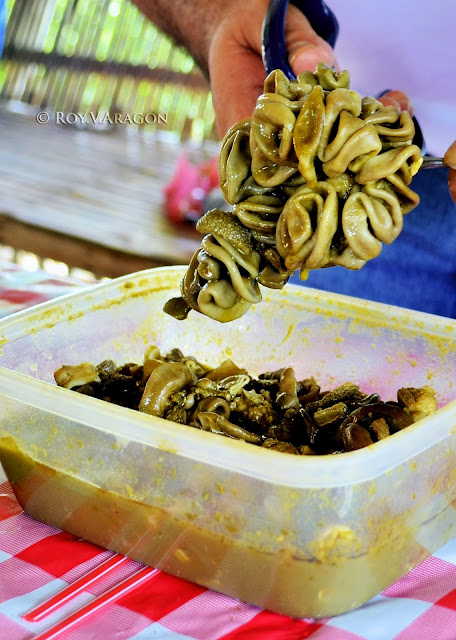Dinengdeng! Also known as inabraw. The staple dish of the Ilokanos to go with innapuy or steamed rice. A medley of vegetables, preferably green leafy veggies, boiled or blanched in bugguong (fish sauce/paste) broth. With or without a sagpaw (an add on of either fish or meat, grilled, fried, or dried).
Or with shellfish. Like kaggo (big brackish water clam). Or tahong (kappo, mussel).
Oh, this is a really different dinengdeng, a first time that I tried to add tahong in it:
 |
| Photographs courtesy of Pinakbet Republic. |
Here, our beloved dinengdeng will comprise saluyot, squash flowers, and kabatiti (sponge gourd):
The veggies are ready:
Boil the bugguong essence in a minimal water, put in the kabatiti first, simmer, then put in the saluyot and squash flowers, steam briefly then put the mussels atop and steam quickly to cook:
And here’s it, my unusual dinengdeng, well, kind of. The tahong’s unique flavor and scent fused with the bugguong’s inherent aroma and the natural sweetness of the fresh veggies made this one dinengdeng phenomenal. And see, it’s gorgeous even, a colorful blend :
More
dinengdengs:
- Dinengdeng, glorious dinengdeng!
- Dinengdeng/inabraw, more, once more
- Dinengdeng once more, because one can live in dinengdeng alone
- "The Dinengdeng Debate: Authencity and Cuisine"
- Dinengdeng a bunga ti singkamas, jicama fruit stew
- Dinengdeng bunga ti singkamas a naalseman iti palali
- Dinengdeng a sabunganay, banana blossom stew
- Dinengdeng a mais, white corn stew/soup
- Dinengdeng a marunggay with kaggo, marunggay leaves and clam soup
- Langka/jackfruit and pallang/winged bean dinengdeng
- Dinengdeng a saba! banana/plantain stew
- Karabasa & utong, squash goodies and string beans stew
- Fresh veggies for dinengdeng in casantolan
- Dinengdeng nga aba, stewed taro leaves/stems/roots
- Kalalaki nga alukon, "male" alukon
- Dinengdeng with tinapa (smoked mackerel)
- Dinengdeng with fried paltat
- Dinengdeng nga uong-mais ken uggot-marunggay, wild mushrooms and marunggay leaves
- Saluyot and rabong variation--with bulong-sili, kalunay and utong
- Buridibod a kamangeg nga addaan pallang ken kalunay sa nasagpawan tinapa
- Red/purple katuday
~~~~~
















































